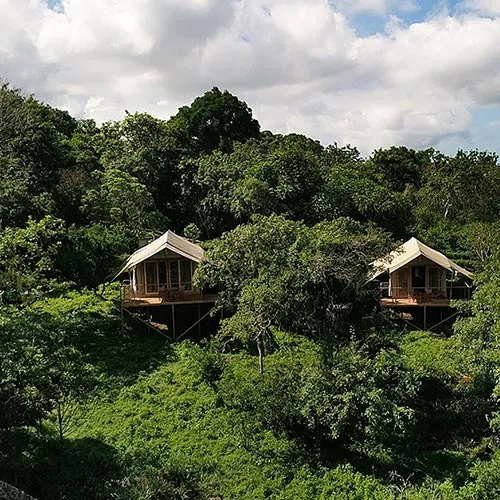Exploring the Galapagos Islands on foot is a unique experience, distinct from many other national parks worldwide due to its extremely strict conservation efforts.
The Galapagos National Park, which covers 97% of the archipelago, enforces regulations that require hikers to be accompanied by an official guide at all times. This ensures the protection of the islands’ delicate ecosystems while allowing visitors to enjoy the breathtaking landscapes and rich biodiversity.
Each visiting site within the park features a clearly marked trail on various uninhabited islands, each offering a glimpse into the islands’ volcanic origins, unique flora, and endemic wildlife. These trails range from easy walks to more challenging hikes, providing opportunities for visitors of all fitness levels to explore the natural beauty of the Galapagos.
The hiking tours we list below are all excursions offered in our Galapagos Safaris.
Hiking on Bartolome Island
After landing on the beach of Sullivan Bay, visitors traverse a wooden walkway and staircase that ends at a lookout spanning the bay, Pinnacle Rock and the eerie barren landscape.
The walk – a steep climb – cuts through the lava fields, through stages of the islands formation by different eruptions of the volcano, the last taking place in 1904.
Read more about Bartolome Island
North Seymour Island
North Seymour Island is a small flat island that has two trails that loop around the island along the coast, through cacti and Palo Santo trees, and past blue-footed booby and frigate bird colonies. Along the coast look out for sea lions basking in the sand. Inland, keep your eyes on the ground for land iguanas. The population was reintroduced in the 1930s and numbered around 2500 when the last census was taken.
This is the place to see the blue-footed booby’s mating dance, and find frigate birds inflating their red pouches to basketball size proportions. The island is 1.9 square kilometres and the trail is easy to navigate, leading from one side of the island to the other.
Read more about North Seymour Island
Santa Fe Island
Santa Fe is another small island with a healthy land iguana population, numbering over 6000. Two trails skirt the island, one that follows the coast passing sea lions, and meandering through tall Santa Fe Opuntia cacti. The other follows a steep incline that ends high on cliffs that overlook the interior of the island and the turquoise waters of the bay below. Keep an eye out for the Santa Fe yellow land iguana, which is endemic to the island and is seen feeding on cactus along the trail. The island is also home to a reclusive, new tortoise population, part of a program to revive tortoises on islands where they were driven to extinction by pirates and whalers.
Read more about Santa Fe Island
South Plaza Island
One of the uninhabited islands close to Santa Cruz that our Safaris can visit during your Galapagos vacation, South Plaza Island is one of the smallest in the archipelago. The trail on this island follows a loop through native cacti and over brightly-colored carpet weed until in arrives at the top of cliffs overlooking the sea. The overlook is a place to see boobies, Swallowtail gulls, and red-billed tropic birds. The island is also home to one of the largest colonies of sea lions in the archipelago.
Read more about South Plaza Island
Santa Cruz Island
While a populated island with Puerto Ayora being a stop on almost every Galapagos vacation, Santa Cruz has hikes that get you away from the city and into the natural world.
Hiking to Cerro Dragon
One hike we enjoy goes to Cerro Dragón, a hill on the other side of the island from the port town known for its land iguanas and bird population.
The site can only be reached by boat, and the trail is one of the longest in the islands. It starts at the beach, loops around the hill with a stop on top, and returns to the coast.
Hiking to Cerro Crocker, Media Luna and Puntudo
Elsewhere on the island is a trail up to Cerro Crocker, Media Luna and Puntudo, three peaks that give you a bird’s eye view of the island and horizon beyond on a clear day.
The trail starts in Bellavista and travels into the highlands of Santa Cruz through miconia trees, past the moon-shaped Media Luna, and to a fork in the path. Going left takes you to Puntudo and right takes you to Cerro Crocker. This is a hike that takes a few hours and puts you deep into the highlands. The terrain can be challenging, but for hikers who want to get out and away from town independently, it’s a great way to spend the day.
For those looking for an active Galapagos vacation, our camp offers plenty to keep you moving during your stay. Exploring the islands by foot puts you in the middle of the natural wildlife and flora that make the archipelago one of the special places in the world.
For more information about our Safaris contact a member of our team.
